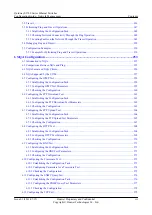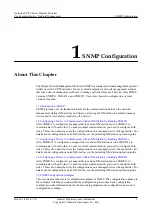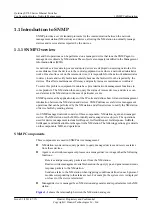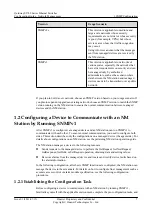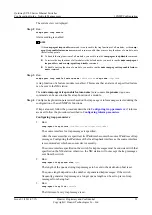
The system view is displayed.
Step 2
(Optional) Run:
snmp-agent
The SNMP agent function is enabled.
By default, the SNMP agent function is disabled. Running any command with the parameter
snmp-agent
can enable the SNMP agent function, so this step is optional.
Step 3
Run:
snmp-agent sys-info
version
v1
The SNMP version is set.
By default, SNMPv3 is enabled.
After SNMPv1 is enabled on the managed device, the device supports both SNMPv1 and
SNMPv3. This means that the device can be monitored and managed by NM stations running
SNMPv1 or SNMPv3.
Step 4
Run:
snmp-agent community
{
read
|
write
}
community-name
The community name is set.
After the community name is set, if no MIB view is configured, the NM station that uses the
community name has rights to access objects in the Viewdefault view (1.3.6.1).
l
read
needs to be configured in the command if the NM station administrator needs the read
permission in a specified view in some cases. For example, a low-level administrator needs
to read certain data.
l
write
needs to be configured in the command if the NM station administrator needs the read
and write permissions in a specified view in some cases. For example, a high-level
administrator needs to read and write certain data.
Step 5
Choose either of the following commands as needed to configure a destination IP address for
the alarms and error codes sent from the device.
l
To configure a destination IPv4 address for the alarms and error codes sent from the device,
run:
snmp-agent target-host trap
address
udp-domain
ip-address
[
udp-port
port-
number
] [
public-net
|
vpn-instance
vpn-instance-name
]
params
securityname
security-string
[
v1
] [
private-netmanager
]
The descriptions of the command parameters are as follows:
l
The default destination UDP port number is 162. In some special cases (for example, port
mirroring is configured to prevent a well-known port from being attacked), the parameter
udp-port
can be used to specify a non-well-known UDP port number. This ensures normal
communication between the NM station and managed device.
l
If the alarms sent from the managed device to the NM station need to be transmitted over a
public network, the parameter
public-net
needs to be configured. If the alarms sent from the
managed device to the NM station need to be transmitted over a private network, the
parameter
vpn-instance
vpn-instance-name
needs to be used to specify a VPN that will take
over the sending task.
l
The parameter
securityname
identifies the alarm sender, which will help you learn the alarm
source.
Quidway S2700 Series Ethernet Switches
Configuration Guide - Network Management
1 SNMP Configuration
Issue 01 (2011-07-15)
Huawei Proprietary and Confidential
Copyright © Huawei Technologies Co., Ltd.
9




